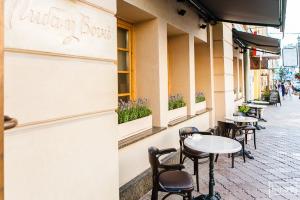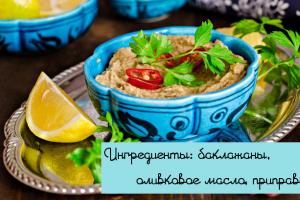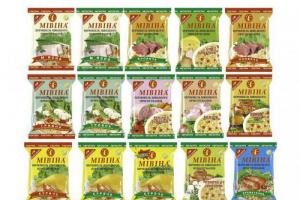Suddenly you feel that your diet has become monotonous and you want to change something, we suggest trying vegetarian pasta.
We share with you recipes for pasta without meat.
Walnut paste
- pasta - 400 g
- walnuts -100 g
- cream - 150 g
- olive oil - 1 tbsp. l.
- parmesan - 50 g
- nutmeg to taste
- salt, pepper - to taste
- green onions - optional
Chop the walnuts and place in a saucepan, leaving a small handful to garnish. Pour the cream over the nuts, add 25 g of grated Parmesan and olive oil. Season with salt, pepper and sprinkle with nutmeg. Stir and heat over medium heat until the sauce thickens.
Boil the pasta in boiling salted water, observing the time indicated on the package. Throw in a colander and add to the prepared sauce. Sprinkle with remaining nuts and Parmesan cheese and chopped green onions before serving.

Vegetarian lasagna with eggplant
- mozzarella - 500 g
- zucchini - 3 pcs.
- eggplant - 2 pcs.
- ready-made dry lasagna sheets - 12 g
- tomato sauce - 1 l
- olive oil -100 g
- grated hard cheese - 2 tbsp. l.
- planning crackers - 2 tbsp. l.
- salt, pepper - to taste
- basil - 1 bunch
Preheat oven to 200 degrees. Then cut the mozzarella into slices and drain. Cut the courgettes and eggplants into slices. Season with salt and pepper and fry in a regular skillet.
Grease a baking dish, place 2 lasagna sheets side by side, brush with tomato sauce. Place the eggplant, zucchini and mozzarella in the next layer. Continue to lay out the ingredients, alternating layers. Sprinkle each leaf with basil leaves and drizzle with olive oil. On top of the last layer of tomato sauce, apply a mixture of cheese and breadcrumbs. Bake for 30 minutes.

Pasta with mushrooms in a creamy sauce
- champignons - 400-500 g
- onions - 2-3 pcs.
- vegetable oil - 100 ml
- cream - 20% 0.5 l
- dry white wine - 0.25 cups
- salt, pepper - to taste
- dry italian herbs
- pasta -250-300 g
- Parmesan cheese - 50 g
In a large saucepan, bring water to a boil, add 2 tsp. salt and 1 tbsp. vegetable oil. Place the pasta in a saucepan and stir to prevent it from sticking to the bottom. Cook the pasta according to the time indicated on the package. Before putting the pasta in a colander, pour out some of the water (1 cup) in which it was cooked. The secret is that it's a wonderful starchy broth that can be added to the sauce if needed. After you have thrown the pasta in a colander, transfer it back to the saucepan, add 2 tablespoons. vegetable oil and stir.
Moving on to the sauce. Peel the mushrooms carefully and rinse under running water. Never put mushrooms in water - they have a loose structure and are instantly saturated with moisture, which will impair their taste.
Then chop up two large onions and mushrooms. Preheat a skillet and sauté the onions in it. Add the mushrooms and fry with the onions for about 20 minutes. Stir and make sure that the onions and mushrooms do not burn. Add dry white wine to them. Simmer mushrooms and onions in wine for 3 minutes. During this time, the alcohol will completely evaporate, only the sourness and aroma will remain.
Now add cream to the pan, salt and pepper if necessary. Stir and simmer for 5 minutes over low heat. Add dry Italian or Provencal herbs, stir, let the sauce simmer for another minute. Add a tablespoon of grated cheese to the sauce. Mix well. Try adding salt and pepper if needed. Combine sauce and pasta and stir well.

Fast pasta with tomatoes and basil
- pasta - 3 handfuls
- tomato - 5-6 pieces
- fresh basil - 15-20 large leaves (preferably green)
- olive oil for frying
- salt to taste
- grated parmesan - 3-4 tbsp. spoons (optional)
In a large saucepan, bring the water to a boil, season with salt and add the pasta. Cook for as long as indicated on the package.
Meanwhile, cut the tomatoes into small cubes and rinse the basil. Gently add the tomatoes to a preheated frying pan with olive oil. Cover and simmer for 2 minutes. Then add the basil and continue simmering with the lid closed for about 2 minutes.
Throw the paste into a colander and rinse lightly under cold running water. Shake out the colander and then add the pasta to the skillet with tomatoes and basil. Stir and simmer for another 2 minutes. When serving, sprinkle with grated Parmesan on top.

Jamie Oliver Pumpkin Pasta
Ingredients:
- Pumpkin - 500 g (already peeled and cut into pieces)
- Pasta - 250 g
- Onions - 1 pc.
- Garlic - 2 cloves
- Chicken or vegetable broth - 200 g
- Thyme
Heat butter and olive oil in a skillet, fry the onion and garlic in them until transparent. Then add pumpkin and sprinkle with thyme. Fry for 5 minutes.
Boil the pasta according to the instructions on the package. While it is cooking, pour the broth into the pumpkin and simmer over low heat, covered for about 20 minutes, until it becomes soft. Mash the pumpkin until puree. Add the paste to the pumpkin and stir. Add olive oil to taste.

Arabiata paste
- pasta - 300 g
- hot pepper - to taste
- garlic to taste
- tomato paste - 400 g
- olive oil
Place the garlic and pepper in a blender. Grind. Heat the olive oil and sauté the garlic and pepper in it. Add tomato paste. Cook until the paste thickens. Now cook the pasta until al dente. Then mix it with the sauce. Serve hot.
Read us at
Telegram
It can be prepared very quickly and often from improvised ingredients. If in the off-season and in winter you want hearty options (and there are a million of them), then in the summer your soul asks for light, vegetable with fresh herbs. In addition, in the heat, the pasta goes well cold. We have collected 10 recipes for vegetarian and vegan pasta, each of which can be further improved according to your taste and taking into account your own beliefs - whether you add cheese or a ham brought back from vacation.
Capellini with broccoli and garlic
INGREDIENTS (for four):
1 box of cappellini
a head of broccoli
a couple of cloves of garlic
salt, spices to taste
COOKING:
Bring water to a boil, add salt and fresh garlic to it. Place the cappellini in a saucepan and cook for 1 minute.
Divide the broccoli into florets, add to the pasta and cook for another 2 minutes until tender.
Drain and serve with a little garlic and seasoning to taste.
If you don't have a cappellini at hand and you are too lazy to run to the store for this type of pasta, replace it with any other one. In this case, at the first stage of cooking, the cooking time should be increased by checking the instructions on the packaging of your pasta.
Cold pasta with sesame oil and bell pepper
INGREDIENTS (for two):
pasta to taste
2 tbsp. l. sesame oil
soy sauce
½ tsp cayenne pepper
1 red pepper, chopped into strips
1 bunch of cilantro
COOKING:
Cook the pasta following the instructions on the package.
Toss it with sesame oil, soy sauce, and cayenne pepper.
Add chopped red pepper and cilantro and stir again.
Cover the pasta and refrigerate for at least 1 hour. Serve cold.
Pesto and spinach pasta

INGREDIENTS (for two):
pasta to taste
175 g of nuts: walnuts and pine nuts are fine
125 g basil leaves
3 cloves of garlic
2 tbsp. l. hard goat cheese, grated
200 ml olive oil
4 large handfuls of spinach
COOKING:
Grind nuts, basil, garlic, cheese and olive oil in a blender.
Simmer the spinach in a skillet, using a couple tablespoons of water instead of oil.
Add pesto to the paste (start with three tablespoons - base on taste) and spinach, serve. Store the leftover pesto in the fridge, it will easily last up to two weeks, but we bet you will eat it much sooner.
Pasta with goat cheese and mushrooms
INGREDIENTS (for two):
pasta to taste
1 tbsp. l. olive oil
3 tbsp. l. dry white wine
150 ml vegetable broth
100 ml cream (or 250 ml cream,
if you do not take vegetable broth)
110 g goat cheese
1 small bunch fresh parsley
200 g of your favorite mushrooms
dry rosemary, basil and thyme
1 clove of garlic
salt and pepper
COOKING:
Fry the mushrooms and prepare the pasta following the instructions on the package.
Combine olive oil, wine, broth and cream in a saucepan, bring to a boil and simmer over low heat until the liquid is halved.
Add parsley, goat cheese, salt, pepper and garlic.
Continue cooking, stirring frequently, until the sauce is thick and smooth.
Add the herbs to the sauce, stir with the mushrooms, place on the pasta and serve immediately.
Pasta with pumpkin and sage

INGREDIENTS (for four):
pasta to taste
3 cloves of garlic, minced
1/2 onion, diced
2 tbsp. l. olive oil
120 ml vegetable broth
120 ml soy milk (or any
vegan milk replacer)
360 ml pumpkin, brought to the consistency of mashed potatoes (you can take canned or fresh, but you have to cook it in advance)
1½ tsp dried sage
salt and pepper to taste
chopped walnuts or cedar
nuts (optional)
COOKING:
Prepare the paste following the instructions on the package.
Fry the garlic and onion in olive oil. Reduce heat to low and add vegetable stock, soy milk, pumpkin, and sage to the skillet. Simmer for 8-10 minutes.
Add salt, pepper and nuts. Stir, remove from heat and serve with pasta.
Asian style curry pasta with vegetables
INGREDIENTS (for two):
pasta to taste
2 tbsp. l. olive oil
1 green pepper, chopped
into thin strips
1 onion, finely chopped
2 cloves of garlic, minced
chili sauce with garlic, to taste
3 tbsp. l. curry powder
2-3 st. l. soy sauce
COOKING:
Cook the pasta following the instructions on the package.
Fry the onions, bell peppers and garlic in olive oil until soft, add the chili sauce and stir well.
Reduce heat and add soy sauce and dry curry to vegetables. Simmer a little so that the sauce saturates the vegetables properly.
Toss vegetables and pasta, serve.
Pasta with avocado and tomatoes

INGREDIENTS (for two):
pasta to taste
1 medium tomato, diced
1-2 stalks of green onions, finely chopped
1 large ripe avocado
¼ teaspoon finely grated garlic
juice from ¼ lemon
salt and pepper to taste
COOKING:
Prepare the paste following the instructions on the package. Before draining the water, save about a glass - you will need the liquid to adjust the thickness of the sauce.
Mash the avocado in a bowl, add garlic and lemon juice, salt and pepper to it. Mix well.
Add some of the water left over from the pasta to the sauce. Combine the resulting sauce with tomatoes, green onions and pasta.
Tagliatelle with caramelized
onions and yogurt
INGREDIENTS (for two):
146 g tagliatelle
425 g onions (about 4 medium onions), chopped thinly
2 tbsp. l. olive oil
1 bay leaf
1 cinnamon stick
1 clove of garlic, minced
50 g Greek yogurt
1½ tbsp. l. milk
2 tbsp. l. chopped fresh dill
15 g butter
¼ h. L. ground cayenne pepper
feta cheese for serving
COOKING:
Place the onion, olive oil, bay leaf, and cinnamon in a heavy-bottomed skillet. Simmer over medium heat, stirring occasionally, until the onions are golden brown, add the garlic and cook for another 2 minutes.
Add some water to the skillet, cover, reduce heat to low, and simmer for about half an hour until the onions are caramelized. Make sure that the water evaporates and the onions do not burn. At this point, if the onions don't caramelize well, you can add a teaspoon of sugar and lemon juice to remove excess sweetness.
Evaporate excess liquid from the pan.
Boil the pasta. When it's almost done, add the yogurt and milk to the onion pan. Heat, but do not bring the sauce to a boil.
Mix pasta and onion, add fresh dill.
Melt the butter in a skillet and add the cayenne pepper to it, cook for 20 seconds.
Slender rows of more than 300 varieties of pasta are confidently conquering the world! Today, pasta (pasta) is recognized as the most favorite food not only in Europe, the USA and Canada, but even in South Africa, the Philippines, Guatemala and Brazil, Peru, Chile, Tunisia. People don't eat as much other food as they eat pasta.
According to experts, pasta is a product with "commercial genes": it is very easy to transport and it can be stored without any problems. But “non-economists” will agree that pasta has special “culinary genes”, since the path from sauces, soups and pasta with filling to baked lasagna leads precisely through agnolotti, cannelloni, manicotti, fettuccine, orzo ...
Initially, the pasta was eaten separately (and mostly by hand). Only over time, various sauces and other products (vegetables, sour milk products, nuts, meat, seafood, mushrooms and legumes) began to be added to it.
Vegan pasta is the "richest" type of pasta, since there are several thousand options for combining vegetables (and even fruits), all kinds of legumes, mushrooms, nuts and seeds, herbs and even flowers for making pasta dishes!
Vegetarian (vegan) pasta: ingredients
Today on the menu - pasta with zucchini and tomatoes
For 3-4 servings you will need:
1. Pasta (any kind) - 200 grams,
2. Zucchini or zucchini - 200 grams,
3. Bow - 1 medium head,
4. Tomatoes - 2 large,
5. Garlic - 2 cloves,
6. Olive oil - about 30 ml,
7. Sunflower oil - about 15-20 ml,
8. Salt, sugar and allspice to taste,
9. Chili and masala for pasta - optional,
10. Greens (the most preferable option is basil) - to taste and desire,
11. Olives - to taste and desire.
Vegetarian pasta: recipe
- Preparing a vegetarian pasta "from scratch" can be done in just 15-20 minutes, if you distribute the time and effort correctly. First, I advise you to put the kettle on to quickly boil water to boil the pasta. While the water is boiling, you can have time to wash the vegetables and prepare them for slicing.
- Add a tablespoon of olive oil to boiling salted water, lower the paste and boil for 3 to 15 minutes (this depends on the shape and thickness of the dough).
- We put a saucepan for the sauce on the stove, pour in the sunflower oil, heat it up. While the oil is heating, chop the garlic very quickly and finely, chop the onion into half rings.
- Put the garlic in a saucepan, and then the onion, leave to fry, in parallel we chop the zucchini / zucchini, cut the tomatoes into slices.
5. Add zucchini and tomatoes, salt, sugar, pepper, a little chili (or masala mixture) to the saucepan. Close and simmer for about 8-10 minutes.
7. Mix pasta with sauce, add olives, herbs, season with olive oil. We heat the pasta with sauce for about 2-3 minutes.
8. We spread the vegetarian pasta with zucchini and tomato sauce, decorate with freshly ground pepper, herbs.
The dish is ready!
How much will 1 serving of vegetarian pasta cost?
Pasta from a local manufacturer - 21 rubles per 400 grams - about 4 rubles,
A bunch of greens - 15 rubles - about 5 rubles,
Zucchini - 25 rubles per kg - 2 rubles,
Tomatoes - 40 rubles per kg - 4 rubles,
Garlic - 0.5 rubles,
Olive oil - 250 rubles per 0.5 liter - 5 rubles,
Sunflower oil - 65 rubles per liter - 1 ruble.
Total: 21.5 rubles
We hope the pasta and zucchini dish - its recipe - will come in handy!
Copyright © 2020
All rights reserved. Use of materials by third-party resources only with an active indexed link to the site.
Do you know what gives a dish a special piquancy? Maybe it's salt, maybe spices, maybe oil? .. Or maybe all together ?!
Combine cashews, salt, olive oil and herbs for a wonderful nutty vegan sauce suitable for pizza or tortillas; Whisk together cherry tomatoes, avocado, half an apple, and hot spices for a delicious, creamy, hot and sweet sauce perfect for any vegetable or cereal. There are an incredible number of vegan sauce recipes that will be a great addition to any meal and will impress both vegan beginners and long-term vegan diets.
A properly prepared sauce will be a great addition to your diet, adding variety and flavor to your vegan diet. Using vegan sauces, you can create a real culinary masterpiece from even the simplest and most affordable ingredients.
Vegan sauce is prepared very simply: by whipping its ingredients in a blender, rubbing with a pestle or grating. Some sauces need to stand for a while so that the ingredients saturate each other, others are recommended to be eaten immediately after cooking. There are those that can be prepared for the winter, and eaten whenever the heart desires.
The tastes of sauces can also differ: some are hot, others sour, and others will be salty, sweet or have a pleasant mild creamy taste. For each dish, you can choose your own vegan sauce or eat sauces depending on how you feel, because with the help of food you can also influence your mood or health!
So, sweetness can be added to the sauce: honey, sesame seeds, barley, almonds and coconuts, dates, raisins, fennel, flax seeds, cinnamon, cardamom, avocado. Sweet sauces should only be consumed in the morning so as not to provoke your laziness. In general, sweet tastes cause a feeling of satisfaction and happiness, but excessive consumption of sweets, and even at the wrong time, may not be the best consequences for the body, for example, the deposition of fat and excessive accumulation of mucus. And on the part of the mood - apathy, laziness and loss of strength.
Sour foods suitable for making vegan sauce are all sour fruits and berries, tomatoes, green grapes, and vinegar. Sour tasting sauces are best eaten between 10 am and 3 pm. The sour taste stimulates digestion and invigorates, but if abused, it will strike the heart, stomach, intestines and mood. People who like to eat a lot of sour foods become touchy, sometimes sarcastic and prone to various barbs.
Salty foods include: the salt itself (preferably sea or Indian pink / black salt for food) and, of course, seaweed. Salt is necessary for our body, but when it becomes too much, it harms the vessels, joints, kidneys, leads to a slowdown in metabolic processes. The person becomes fussy and tense. Eat salty vegan sauces during the day and you will never experience the harm that can come with overuse of salty tastes.
Bitter taste is possessed by: lettuce, sorrel, spinach, saffron, turmeric. The bitter taste helps cleanse the blood, remove toxins, and has anti-inflammatory and antibacterial effects. But excessive enthusiasm for bitter tastes can lead to constipation, make a person depressed and conflicted. It also happens that the craving for bitter taste is caused by a depressive state, an internal feeling of grief. Spicy tastes include: asafoetida, peppermint, all kinds of pepper, thyme, cloves, cardamom, cumin, coriander, horseradish, mustard. In moderate quantities, the pungent taste helps to warm up, improves metabolism, tones up the entire body, liquefies phlegm and kills worms, improves mood. But, if you eat too much spicy food, it will lead to stomach and intestinal problems, anger, irritability, excessive emotionality and frequent mood swings. If you eat hot sauce in the morning, then you risk spending all your energy by lunchtime. Persimmons, pomegranates, black currants, unripe bananas, chickpeas and oak bark are astringent. It is advisable to eat these products during the day, 5-6 hours before bedtime. Astringent tastes will give energy, help with a breakdown. Astringent flavors also help improve digestion, purify the blood and give the face a blooming appearance. But with excessive use, they cause excessive nervous excitability, anxiety and put a great strain on the heart. Everything is good in moderation!
There are many recipes for vegan sauces, each with its own unique taste, color and texture. Sometimes, when preparing a sauce from the same ingredients, in the end you can end up with products that taste slightly different from each other. The same can happen when different people cook according to the same recipe. Why is this happening? It's simple, the prepared dish will be influenced not only by the recipe, but also by the internal state of the cook, the quality of the ingredients, and their freshness. So choose carefully what will make up your vegan sauce. Om!








